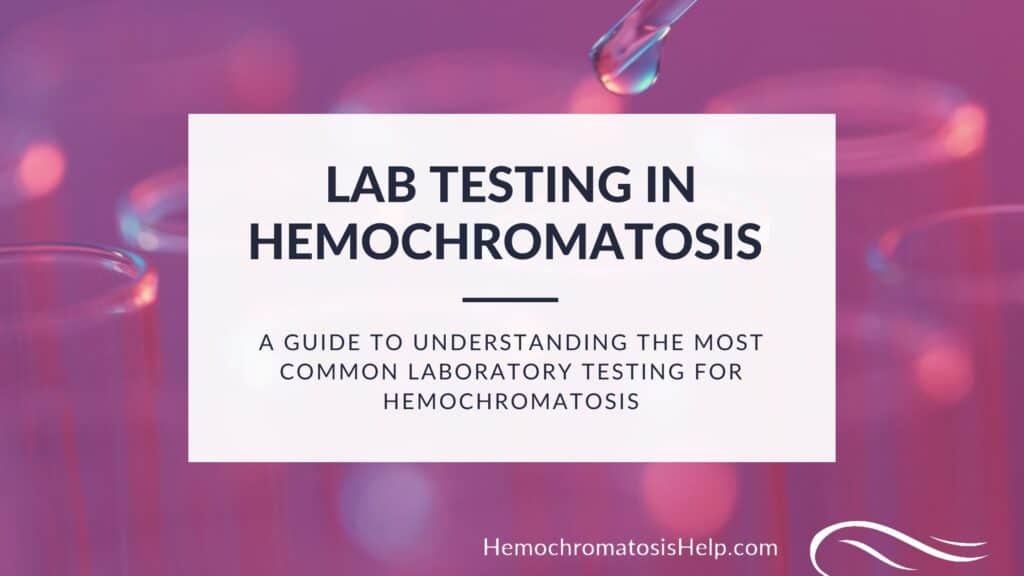Benefits of Lab Testing in Hemochromatosis
Awareness is essential for iron overload. Hundreds of thousands of people carry the genetics associated with hereditary hemochromatosis, yet many have no idea.
Some estimates show 1 in 9 people of Northern European descent is a carrier of the genetic mutation that can cause this disease. Entire families may be impacted without their knowledge!
For something so common, one might think that everyone would have heard of this condition. You might assume it would be part of routine blood testing done by physicians, and that people with the disease would have a vast support network and understanding by their doctors, friends, and community.
Unfortunately, hemochromatosis is frequently misdiagnosed by doctors, or not diagnosed at all, resulting in people suffering unnecessarily, feeling alone in their deteriorating health.
Many times their friends and family members have never even heard of the condition, leading to feelings of being an outsider with a strange condition no one can pronounce.
The Top Two Reasons for Doing Lab Tests for Iron Overload
Laboratory testing is beneficial in two main ways.
- First, it helps in the discovery and diagnosis of the condition.
- Second, it’s critical in the monitoring and follow-up necessary to see how well iron levels are controlled.
Using Lab Tests to Diagnose Hereditary Hemochromatosis
Hemochromatosis is diagnosed by a combination of blood tests looking at iron markers in the body and then confirmed by genetic analysis. As a genetic condition that is passed down to other blood relatives, many times, a healthcare provider is alerted to check for this condition after another family member tests positive.
A diagnosis of hemochromatosis may happen in several steps. Even though iron overload is a relatively common genetic disorder, many people go years or decades before they find out they have it.
Many doctors may not consider hemochromatosis in their diagnosis because they are thinking about other conditions that may have a similar presentation, such as arthritis, menopause, or general fatigue caused by any number of different reasons. It is essential, however, that healthcare providers include iron overload in their differential diagnosis thought process.
Furthermore, the signs and symptoms of iron overload are often different for women and men. This may affect diagnosis because a doctor will have to account for the different ways a person may experience hemochromatosis.
Even though there are individual and gender differences in iron overload, doctors can still come to a diagnosis of hemochromatosis based on a number of tests.
The two most important tests to begin diagnosing iron overload are transferrin saturation and ferritin. Some doctors prefer to do these tests separately from one another, and some doctors like to do these tests together, so your experience will likely depend on your physician’s preferences for blood testing.
If transferrin saturation and/or ferritin are elevated, the next step in hemochromatosis diagnosis is often genetic testing.
Genetic testing often entails another blood draw, although some lab companies offer a test that involves swabbing the inside of your mouth to collect cells to test. Both tests are evaluating the DNA for possible changes of the HFE gene, specifically for the C282Y and H63D alleles.
Once a physician has evaluated a person’s signs and symptoms, his or her transferrin saturation and ferritin levels, and the genetic test, a diagnosis of hemochromatosis may be made.
Using Lab Tests to Monitor Your Iron Overload
Watching how your ferritin and transferrin saturation numbers change over time is also an excellent way for your doctor to track how you are doing.
Lab tests are valuable in monitoring treatment and overall health after a hemochromatosis diagnosis. If therapeutic phlebotomy has been recommended, it is essential to monitor your blood levels to ensure you don’t give too much blood too fast. On the flip-side, blood tests can ensure you are doing the phlebotomy frequently enough.
Common Blood Tests in Hemochromatosis
Serum Iron gives us a glance at the current level of iron in our bloodstream. Serum iron is not “free iron” but rather the quantity of iron bound to transferrin in our blood. Serum iron levels can fluctuate up and down, and therefore they are not as reliable as some other tests in diagnosing or monitoring hemochromatosis. A one-time test of slightly elevated serum iron is not enough to diagnose hemochromatosis, as other reasons might cause serum iron levels to rise, such as inflammation or infection.
Ferritin Level, sometimes called the “storage form of iron,” is the most significant lab test to monitor the state of your condition and the progress of your treatment. The lab test for ferritin serves as an important way to estimate iron levels in the body and cells. Ferritin’s job is to bind to excess iron in the blood, thereby reducing the harmful oxidation potential and toxicity of free iron. Ferritin may also increase during times of infection, inflammation, or liver disease. However, elevated ferritin most often reflects a state of excess iron and becomes an important marker for evaluating hemochromatosis. [Learn more about ferritin]
Transferrin Saturation is a ratio of serum iron to total iron-binding capacity (multiplied by 100). This value represents the percentage of how much iron is bound to the blood protein transferrin. Because the body is continually absorbing more iron from food than it needs to in iron overload, there is a constant influx of iron into the blood. Transferrin attempts to keep up with this excess by rapidly binding and transporting iron to the cells. The more iron in the body, the more iron that is bound to transferrin, and therefore the more “saturated” with iron the transferrin becomes. This is why elevated transferrin saturation is positively correlated with hemochromatosis and is often the first clue that someone might have iron overload. [Learn more about transferrin saturation]
Unsaturated/Unbound Iron-Binding Capacity (UIBC)- This is the amount of free iron in the blood, unbound and causing oxidative damage. In the unbound form, excess iron is toxic to our tissues and organs. Free iron is a “pro-oxidant” and creates free radicals that will destroy the healthy function of our cells.
Total Iron-Binding Capacity (TIBC) measures, as you might guess, the available capacity of the blood to bind iron.
The HFE Gene Blood Test determines if an individual’s DNA contains either of the significant variations associated with hemochromatosis: C282Y and H63D. [Learn more about the HFE gene]
Additionally, the following are standard blood tests for liver function, a frequently affected organ in hemochromatosis:
- AST & ALT- These are the most commonly tested liver enzymes. If there is damage to the cells of the liver, these enzymes may be elevated in the blood.
- ALP & GGT- Other liver markers that may be tested. If the flow of bile from the liver is impaired, these enzymes may be elevated in the blood.
- Triglycerides, Cholesterol, Blood Sugar- These metabolic markers can rise for a variety of reasons, including decreased liver function.
What Do Test Results Mean for Hemochromatosis?
Many patients who suspect they might have iron overload or who have family members who have been diagnosed can share their concerns with the physicians and ask them to run an iron panel. A complete iron panel typically includes:
- Ferritin
- Transferrin Saturation %
- Serum Iron
- TIBC/UIBC
These are all tested via a routine blood test and are most accurate if done fasting.
An iron panel will evaluate your serum iron and your TIBC (Total Iron Binding Capacity), as well as the two tests I find most useful: Ferritin and Transferrin Saturation %.
Ferritin is a measurement of stored iron within the cells. Iron within our cells is the most damaging to our long term health, thus ferritin is of extreme importance to understand. Suspicion rises with a ferritin over 300 in men and over 200 in women.
When ferritin levels rise above 1,000 a consideration for liver biopsy is made since the liver is the most vulnerable organ to the affects of genetic hemochromatosis.
Transferrin Saturation (TS%) is a ratio of serum iron to total iron binding capacity (multiplied by 100), and this value represents how much iron is in a bound form. When the percentage of bound iron increases dramatically, it represents a system overloaded with iron.
Once a TS% is greater than 50% in men and greater than 45% in women (on 2 occasions), this finding is suggestive of genetic hemochromatosis.
Many times doctors may not find it necessary to jump straight to the genetic testing, but if you know it runs in your family, your doctor may run the genetic test at the same time. Other times the genetics are run after abnormal numbers show up from the iron panel.
What If My Doctor Won’t Run These Tests For Me?
I’ve gotten this question a lot. Some people don’t fit the typical profile, so their healthcare practitioner doesn’t think it’s necessary. Or your doctor may not be familiar with hemochromatosis testing.
In that case, I do have an alternative option to provide. We’ve partnered with DirectLabs, an accurate, confidential, and inexpensive provider of lab testing (available in the USA only).
Learn how DirectLabs can help you get the testing you need at an affordable price.
Bottom Line About Hemochromatosis Lab Tests
Hemochromatosis testing is essential for many reasons.
All the time, I hear from people who suspect that they may have iron overload but who have never been tested.
Perhaps even more common is the story of a person diagnosed with hereditary hemochromatosis, but their family members have not yet been checked.
In either case, lab testing can be an essential first step in identifying the root cause of too much iron. Once someone has received the proper hemochromatosis testing, they can then go about taking the steps needed to get themselves healthier.




